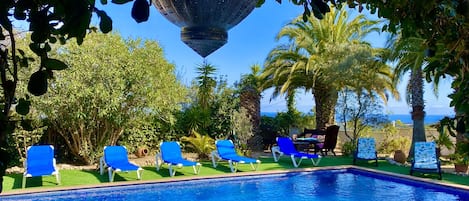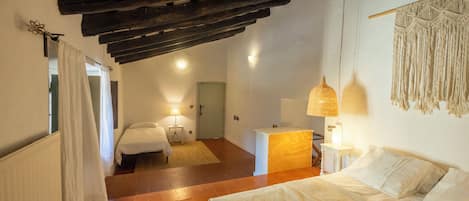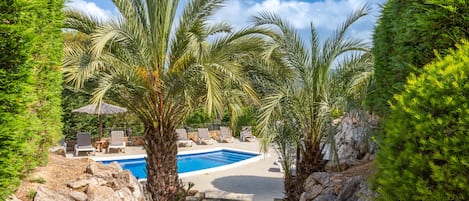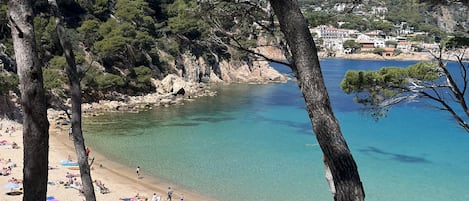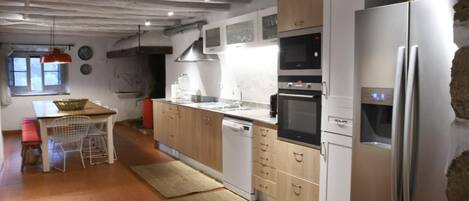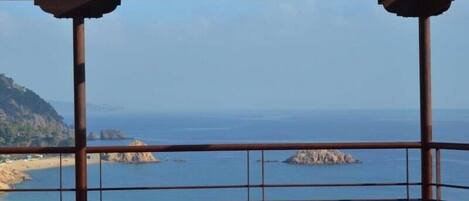This holiday cottage or “masía”, which we have recently renovated, boasts a total of 6 bedrooms, 3 of which are ensuite while the other 3 share a bathroom. With 14 beds in the 6 bedrooms, it can happily accommodate 14 guests.
It has 2 living rooms, the first of which is extremely comfortable and ideal for curling up to read a book or for a nice nap after the barbecue. The second living room is perfect for watching a film or one of those modern series everyone is so keen on nowadays.
The kitchen is fully equipped so you don’t need to worry - you’ll not have to cook as if you were back in the middle ages. The kitchen also opens directly into the sitting room, where an amazing fireplace awaits. Here you can enjoy the warmth and the crackling of the wood as you snuggle up with your partner, friends or pets.
Maybe we shouldn't say so ourselves, seeing as it is our rural house after all, but the outdoor area is simply spectacular! There’s a barbecue that is just perfect for lovers of grilled meat and vegetables, calçots, paella, etc., a solarium where you can get a tan, and a 10 x 5 metre swimming pool, which is ideal for a refreshing dip in spring and even more so in summer. The house also has a covered patio/terrace with lovely views where you can enjoy a vermouth while the kids frolic in the pool or have lunch and dinner during the hot summer days.
The rural house is located in a beautiful and congenial setting, surrounded by a pine forest that you city folk will love. Take a deep breath when you get out of the car to soak in the fresh air and the peace and quiet of the countryside.
Our holiday cottage or, as we say in Catalonia, our “masía”, is not just any old house, its thick stone walls tell a story that stretches back for five centuries - pretty impressive, right?
Some of you may be wondering just what a masía is. Well, in a nutshell... Here in Catalonia and in the south of France, between the ninth and tenth centuries, people began to build houses like ours, rural buildings for family farming and cattle raising. In other words, the people who lived in these houses were usually families who were involved in agriculture and/or livestock farming.
The materials most widely used in their construction have always been unpolished stones, although later on this material was replaced by cement or lime mortar. All the masías share a few common characteristics: their main façade faces south and their walls are between 30 and 50 cm thick. This keeps them cool in the summer and, thanks to the fireplace, warm in the winter. They were normally built on 2 floors. The first floor was used for farm work and the second floor was set aside as a residence for the family itself.
Our rural house, as we mentioned earlier, was built some 500 years ago, but if you want to explore it you’ll have to rent it out! Come and visit us and we’ll tell you all about it in person, which is always much more fun.
What makes this space unique?
The rural house is located in the municipality of Santa Cristina d´Aro, on the edge of the Gironés and La Selva, in the Baix Empordà region. Santa Cristina d´Aro is one of the most beautiful medieval villages on the Costa Brava, so we recommend you take a stroll through it as soon as you get here.
The holiday cottage is surrounded by a beautiful pine forest and there are no neighbours in the vicinity, which makes it ideal for large groups and families as you’ll not have to worry about whether you’re disturbing the residents of the area or neighbours.
Services and common areas:
The holiday cottage is secluded, with no neighbours to bother, and it has several common areas, including a private swimming pool, a solarium, 2 separate living rooms, a large kitchen and a large sitting room with an impressive fireplace.
In addition, the house is fully equipped with all the mod cons of the 21st century such as kitchen utensils, television, heating, air conditioning and basic hygiene elements for all guests. Cleaning is included in the price.
We like to take care of our guests:
We do, we take good care of you. When you arrive, the person in charge of the house, Jordi, will show you round the entire house so you can begin to feel at home. He will also tell you about all the places of interest you can visit in the area, which is indeed quite beautiful. Also, if you’re interested, Jordi can share the history of this old masía with you - it was built 500 years ago, a long time, in anyone's book.
Other highlights:
Most people who head off to a masía or a rural house to spend the weekend usually bring their own food with them which they either buy in their own city or cook in advance, but don’t forget that we have a barbecue you can use. If you don’t want to load all those groceries into your car before you leave home, there is a supermarket near the house, just some 5 minutes away by car. There is also a chemist’s, a bar and a restaurant in the village.
Don’t forget that we are only 6 km from the beach. You can cycle all the way there along the greenway that runs from Olot to Sant Feliu. We also recommend that you try the local gastronomy one day. There are several restaurants in the area with delicious menus, cooked with locally sourced ingredients and produce.
The neighbourhood (the area):
Most people who visit us want to take a break from their day-to-day routine and to rest for a few days, swimming in the pool, relaxing by the fireplace, enjoying the weather, friends and family... But if you want to head out and explore the area, here’s a list of places we think are well worth visiting.
The megalithic tomb at Daina’s Cave, in Romanyà de la Selva.
The Church of Santa Cristina, in pre-Romanesque style and with Paleochristian remains.
The Church of Santa Maria de Bell-lloc, which was built on the site of earlier Roman and Paleochristian constructions.
The pre-Romanesque church of Sant Martí, in Romanyà de la Selva.
The Church of Santa Agnès, in Solius, from the 18th century.
The Enrique Sacristán Zarzuela Museum which houses a collection of pieces related to the world of the theatrical musical genre known as Zarzuela. It also illustrates the links with the baritone Enrique Sacristán, who dedicated his life to this lyrical genre.
The monastery of Santa Maria de Solius, where you can find the Solius collection of Nativity scene dioramas. This is a collection of great artistic, popular and religious value, thanks to the work of Brother Gilbert Galcerán, who transmits sensitivity in the smallest details.
The Great Museum of Magic. The Xevi Collection: this museum is located in a Catalan masía that was built in 1850 in the old part of the town. It is the home of the Great Museum of Magic, a cultural facility inaugurated in 2002 and managed by Xavier Sala i Costa, known internationally in the world of magic as Xevi.
Directions
The best way to get here is to drive. We will send you the location on Google Maps just as soon as you book your accommodation.





